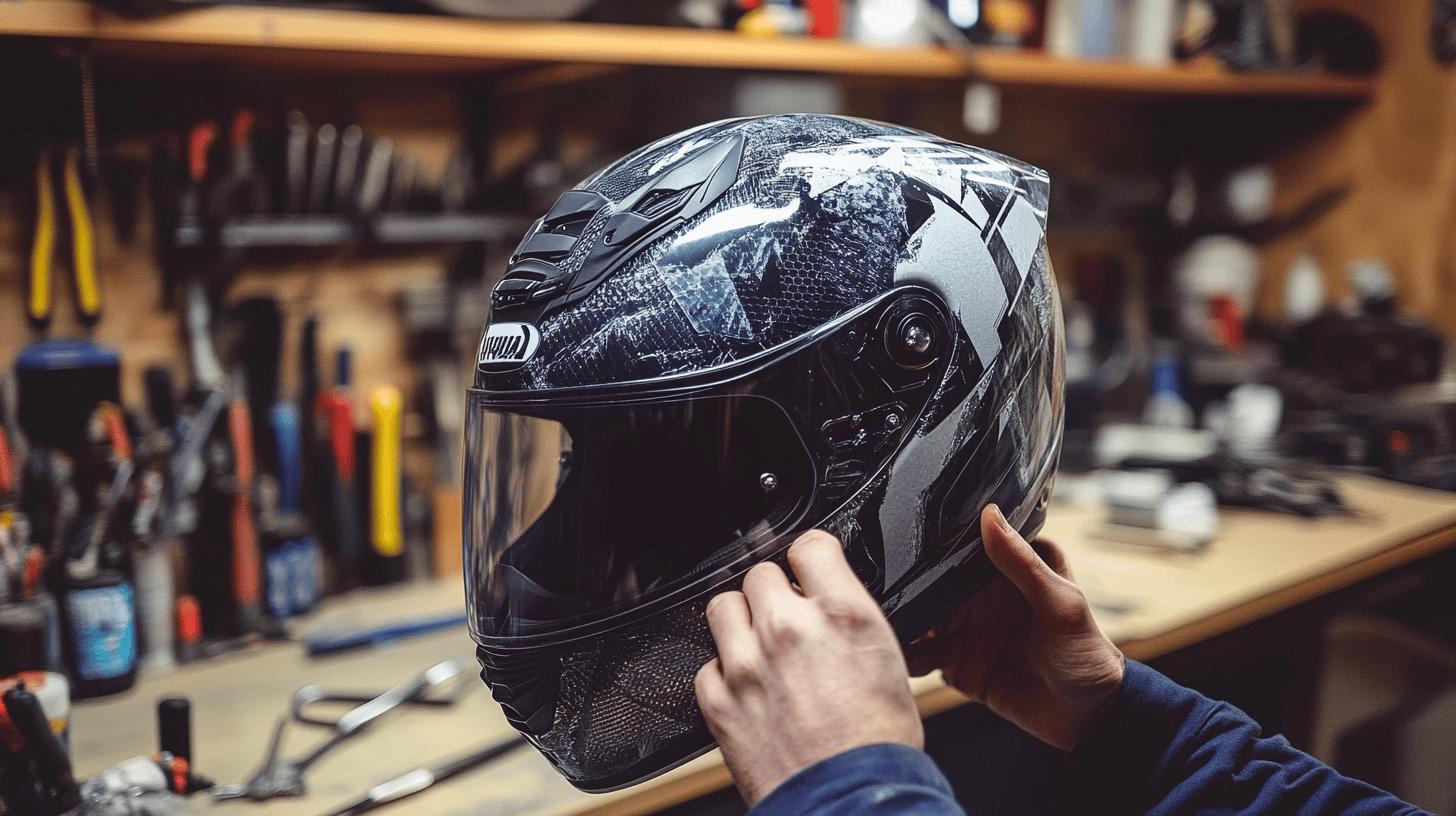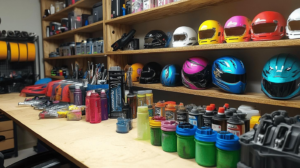Ever been on a ride where the wind punches harder than the throttle? Motorcycle helmets are vital for safety, yet many riders find themselves battling relentless noise.
Transforming your helmet into a sanctuary of quiet is achievable with soundproofing techniques that focus on reducing wind and engine sounds. Effective noise reduction boosts comfort and concentration, allowing riders to savor every twist and turn without distraction.
Through strategic use of materials like acoustic foam and neoprene padding, you can significantly cut the chaos and ride in peace. Dive into the world of helmet soundproofing and enhance your riding experience like never before.
Understanding the Basics of Soundproofing a Motorcycle Helmet

Reducing noise in a motorcycle helmet is crucial for enhancing riding comfort and protecting against hearing damage. By minimizing wind, engine, and external noise, riders can maintain better focus and enjoy a more pleasant experience on the road.
Acoustic foam plays a pivotal role in soundproofing. It absorbs and diffuses sound waves, effectively reducing wind noise. Neoprene padding is another valuable material, known for its ability to dampen vibrations.
By incorporating these materials into the helmet's interior, riders can achieve significant noise reduction. Custom inserts, made from foam or gel, can also be fitted to the helmet's shape, enhancing both sound dampening and comfort.
Proper helmet fit and aerodynamics are essential for effective noise reduction. A snug fit prevents air from entering and causing turbulence, which can amplify noise. Helmets designed with streamlined shapes and features such as fins and ridges help reduce wind resistance and minimize noise.
A well-sealed visor further blocks air intrusion, contributing to a quieter ride. Prioritizing these elements ensures both safety and a reduction in disruptive noise levels while riding.
Step-by-Step Guide to Soundproofing Your Helmet

Soundproofing a motorcycle helmet involves using specialized materials to enhance comfort and reduce noise. Essential tools and materials include Dynamat, acoustic foam, neoprene padding, a utility knife, and adhesive. These materials help reduce helmet noise by 20-30%, creating a quieter ride.
- Remove the Cheek Pads
Begin by detaching the cheek pads from inside the helmet. Typically, these are secured with buttons and screws. Carefully remove them to expose the helmet's inner shell.
- Trace and Cut Soundproof Material
Use a utility knife to trace the helmet’s interior shape onto your chosen soundproofing material, such as Dynamat or acoustic foam. Be precise to ensure a perfect fit, avoiding areas where vents are located to maintain airflow.
- Apply the Material Carefully
Attach the cut soundproofing pieces to the inner shell using adhesive. Press firmly to secure them in place. Ensure no gaps are left, as these can allow noise to seep through.
- Reinstall the Cheek Pads
Once the soundproofing material is installed, reattach the cheek pads. Ensure they fit snugly, as this helps in maintaining a proper helmet fit and maximizing noise reduction.
- Test and Adjust
Wear the helmet to test the noise reduction. If needed, adjust the placement of the materials or add additional layers where necessary, ensuring no vent blockages occur.
Soundproofing a helmet can increase its weight, potentially affecting comfort during long rides. While the added weight may seem minor, it's important to balance between achieving effective noise reduction and maintaining comfort.
Consider the helmet's original weight and how additional materials may impact your riding experience. By evaluating and adjusting accordingly, riders can enjoy a quieter ride without compromising on comfort.
Enhancing Noise Reduction with Aftermarket Products

Noise reduction in motorcycle helmets can be significantly improved with the use of aftermarket products. Noise-canceling devices are among the most effective solutions, actively reducing unwanted ambient sounds.
High-performance earplugs, designed specifically for motorcyclists, can also drastically cut down on wind and engine noise, providing a peaceful riding experience. These accessories work by minimizing sound intrusion, allowing riders to maintain focus and enjoy their journey without distractions.
-
Cardo JBL Audio Sets: These systems replace wind noise with high-quality audio, allowing riders to listen to music or take calls without compromising awareness.
-
Shoei RF-1400 Helmets: Known for their aerodynamic design, these helmets feature noise-reducing elements that limit turbulence and external sound.
-
Custom-Molded Earplugs: Tailored to fit the ear perfectly, these earplugs offer superior noise reduction compared to standard options.
- Wind Blockers: These attachments shield the neck area, preventing wind from entering the helmet and reducing noise levels significantly.
Incorporating these aftermarket products into your riding gear offers substantial advantages. Riders benefit from reduced noise fatigue, leading to longer and more comfortable journeys. Enhanced auditory clarity means that crucial sounds, such as communication devices or traffic signals, remain audible.
Additionally, these products can extend the lifespan of hearing health by protecting against excessive noise exposure. By investing in quality noise-reduction accessories, riders can achieve a balance of comfort and safety, making every ride an enjoyable experience.
Balancing Noise Reduction and Safety in Helmets

A properly fitting helmet is crucial for both noise reduction and safety. A snug fit is key, as it limits air entry, reducing wind noise and preventing turbulence that can amplify sound inside the helmet. This fit ensures that the helmet remains secure during rides, providing the necessary protection in case of an impact.
An ill-fitting helmet, regardless of its noise-reducing features, may not adequately protect the rider's head, compromising safety. Helmets should meet established safety standards, like DOT or ECE certifications, to assure riders of their protective capabilities while also addressing noise concerns.
Achieving a balance between comfort and noise reduction is essential, without compromising safety. Riders should aim for helmets that offer both a comfortable fit and effective noise control features. Options such as adjustable padding, streamlined designs, and high-quality seals around the visor can reduce noise levels while maintaining a comfortable wearing experience.
It's important for riders to prioritize safety over achieving a quieter ride, ensuring that any modifications or aftermarket solutions do not impair the helmet's protective integrity. By selecting helmets with integrated noise-reducing elements, riders can enjoy quieter and safer journeys.
Evaluating Soundproofing Effectiveness and Rider Feedback

Riders often experience a 20-30% reduction in noise levels after applying soundproof materials to their helmets. This level of noise reduction significantly enhances riding comfort, allowing for clearer communication and less fatigue over long distances.
Users report that materials like acoustic foam and Dynamat effectively reduce wind and engine noise, provided they are applied correctly. The decrease in noise not only improves the riding experience but also contributes to better focus and increased safety.
Common themes from rider feedback include:
-
Additional Layers: Some riders find that adding more layers of soundproofing material can further reduce noise levels, especially at higher speeds.
-
Technique Adjustments: Proper placement and secure adhesion of materials are crucial to effectiveness; riders often adjust techniques for better results.
-
Material Compatibility: Ensuring materials do not obstruct helmet vents is essential to maintain airflow and comfort.
Using rider feedback is key to refining soundproofing strategies. Evaluating the effectiveness of current methods helps identify areas for improvement, such as optimizing material types or application techniques.
Continuous feedback allows for the development of more efficient soundproofing solutions, enhancing both noise reduction and the overall riding experience. By incorporating this feedback, riders can achieve a quieter ride without sacrificing helmet functionality or safety.
Final Words
Exploring how to soundproof a motorcycle helmet involves a blend of basic concepts, practical steps, and smart use of aftermarket products. Effective soundproofing significantly enhances riding comfort by minimizing disruptive noises.
While DIY methods provide an engaging approach to noise reduction, aftermarket solutions offer convenient enhancements. Balancing these strategies with helmet safety ensures an optimized riding experience. Implementing soundproofing techniques pays off by improving the overall enjoyment and focus during rides.
FAQ
How can you make a motorcycle helmet quiet?
Using the right materials like acoustic foam and neoprene padding can reduce noise by absorbing and diffusing sound waves. Ensuring the helmet fits well and is aerodynamically designed helps minimize noise further.
How do you stop wind noise in your helmet?
Reducing wind noise involves using noise-canceling devices, ensuring a proper helmet fit, and applying soundproof materials that don't block ventilation. Aftermarket wind blockers can also be effective.
What are legal considerations for motorcycle helmet speakers?
Motorcycle helmet speakers are typically legal as long as they don't impede environmental awareness. It's crucial to check local laws for specific regulations about using speakers while riding.
Can you still hear surrounding sounds when wearing a motorcycle helmet?
Motorcycle helmets, even when soundproofed, should allow riders to hear critical environmental sounds. Balancing noise reduction with ambient sound awareness is key for safety.
What makes the Shoei RF‑1400 Helmet noteworthy for sound reduction?
The Shoei RF‑1400 Helmet features advanced aerodynamics and interior padding designed to minimize wind and external noise, enhancing the quietness and comfort of the ride.

Mark Anderson is a trusted expert with over 25 years of riding experience. At 56, his deep knowledge of long-distance touring and participation in major motorcycle rallies makes him a reliable source for gear recommendations on ProtectiveGearz. Mark’s decades of firsthand experience ensure his advice is authoritative and valuable to riders seeking expert guidance.



